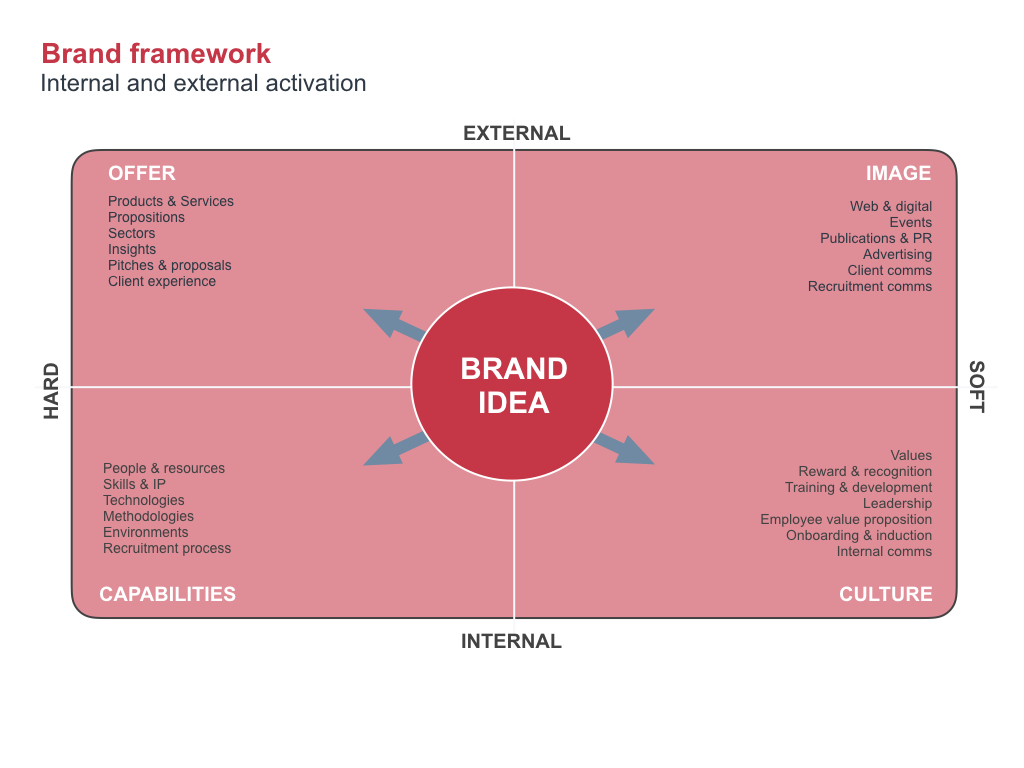Symbols & substance - great brands do both
Symbols are one of the most powerful elements of a good brand strategy but are often overlooked by traditional management consultants because they lean as heavily on EQ as IQ.
That makes CMOs of professional service firms uniquely qualified to create and nurture strong symbols to help project what makes their firm distinctive in the market.
By helping develop brand symbols CMOs can become more strategically influential within their firms because they involve much more than communications.
Brand symbols are everywhere.
Stand for, to stand out
What exactly is a brand symbol? They come in many shapes and sizes but whether big or small they punch above their weight in terms of their ability to cut through and communicate something about the brand strategy that might otherwise get lost in all the noise.
Richard Branson’s Virgin Atlantic has always worked hard to differentiate its customer experience from its much bigger flag carrier competitors. Not easy in a business where so much of the ‘product’ is literally commoditised – same airplanes, same airports, same security and immigration services.
One of the ways Virgin does this is with its airport lounges – called Clubhouses – for its business class and most loyal customers. If you’ve ever stepped into one you’ll remember the experience. Everything from the lighting and interior design to the shoe-shine service and spa/hair salon creates a powerful symbol of what Virgin stands for.
Another example, from a brand that uses symbols masterfully, is Apple’s packaging. Apple understands the ritual and ceremony that goes along with unwrapping a new and relatively expensive product like a new iPhone or even some new earphones.
The packaging is as well designed as the product inside, from the density of the card to the sophistication of the protective stickers that envelop the device.
They even go to the trouble of creating a small vacuum inside the box so that it feels better when you open it. Steve Jobs would have been proud of that one!
Brand symbols are everywhere when you look. When you think of any brand in your head that means something to you, you’ll probably land on something ’symbolic’ — something that symbolises a bigger more substantial idea about a brand.
While most marketers appreciate the value of communicating existing brand symbols, fewer realise that they can be created as well.
Coming to the world of brand differentiation in professional services, McKinsey’s — highly valuable — brand is built on an intense belief in the power of rigorous analysis. As they say themselves, “Our work is founded on a rigorous understanding of every client’s institutional context, sector dynamics, and macroeconomic environment.” It’s part of what makes them the brand leader in their field.
They hire the ‘brightest and best’ analysts and have more PHDs on the team than many universities, but still, it’s hard to get this across clearly. A brand symbol that McKinsey has created to help them project their difference is the McKinsey Global Institute.
Everything from the name through to the topics it covers: “How could Earth’s changing climate impact socioeconomic systems across the world in the next three decades?” sounds more like a university than a strategy consulting firm.
It’s not a university, it probably doesn’t even have a physical location — the McKinsey people associated with it are dispersed around the world — but still, it successfully helps project and reinforce the idea that the brand stands for rigour. Academic rigour in this case.
Another iconic example of a brand symbol in premium legal services is Kirkland & Ellis’ branded client experience in litigation. No, of course, they don’t call it that but they do it as well as any super-luxury hotel chain.
Over the years Kirkland has landed on a ‘way’ of doing litigation – usually referred to by people inside and outside the firm in militaristic terms such as ‘scorched-earth approach’ or ‘take no prisoners’ – and they’ve turned it into their signature client experience.
Brand symbols are a powerful way to communicate what you stand for because they cut through a saturated world of claims and propositions that inevitably sounds very similar, from the position of a prospective client or recruit. The propositions still have a key role to play but combined with strong symbols the propositions are more compelling.
The very best marketers use the power of symbols relentlessly.
Way to go
Whilst most marketers appreciate the value of communicating existing brand symbols in their marketing plans, far fewer realise that they can be created as well. And furthermore, as CMO they are in a unique position in a professional services firm to lead the creation and implementation of those brand symbols.
As marketing becomes a more sophisticated and strategic discipline in the professional services sector it’s also important to remember that within the 5-7 Ps of the marketing mix — the number of Ps is gradually increasing with time — are product, place, and people. It’s marketing, not just marketing communications.
The very best marketers: Steve Jobs, Richard Branson, and Phil Knight, pulled on all the P levers to develop and project their brands — using the power of symbols relentlessly as they went.
Admittedly it’s easier to get permission to reach across the whole set when you’re the boss, but the lesson for marketers is that great marketing requires it.
If you’re the CMO — not the CEO — you do need to take others with you in the decision making but I’ve noticed many times that the best do this to great effect and don’t limit their influence to the one area where they don’t have to ask permission — communications.
Whether the task is to nurture existing symbols or create some new ones from scratch the process isn’t that different.
At Principia, we use the quadrants model (below) as a starting point. Once we know what we’re aiming to project to the market we use this framework to develop a range of ideas that could be potential brand symbols.
 Using this framework ensures we aren’t restricting ourselves to communication ideas alone — although this doesn’t exclude them either — and we ask ourselves, “what could we do in any of these areas that would, just by their existence, symbolise what we want the market to know about us.”
Using this framework ensures we aren’t restricting ourselves to communication ideas alone — although this doesn’t exclude them either — and we ask ourselves, “what could we do in any of these areas that would, just by their existence, symbolise what we want the market to know about us.”
Brand symbols are powerful weapons and done well can cut through in ways that communications alone can’t match.
Initially, the long list contains many ideas that are fundamentally unworkable but by adopting a sifting process of “if not this, then what?” you end up with a shortlist of ambitious but not totally crazy ideas.
Then once these are worked up into bare-bones concepts (typically, one-slide sketches of the ideas) then that’s the time to start involving leadership colleagues who have line management responsibility for the resources that each idea involves.
Deciding on when the right moment is for this is an art rather than a science and differs from organisation to organisation depending on the business and leadership culture — too soon and the ideas aren’t compelling, too late and they tend to invoke defensiveness rather than collaboration. You want and need collaboration.
I often use the example of Netflix’s no rules vacation policy, “Our vacation policy is “take vacation.” We don’t have any rules or forms around how many weeks per year,” as a way to think through the actual challenges of what at first might seem an unworkable idea.
It’s a good example of a brand symbol in itself, and one that everyone tends to instinctively think ‘wouldn’t work here.’ Thinking about how the people at Netflix might have first discussed it around the leadership table helps people get into the right mindset.
Just do it
Brand symbols are powerful weapons and done well can cut through in ways that communications alone can’t match.
Marketers are uniquely positioned in professional service firms to take a lead on developing and nurturing these symbols, even though doing so inevitably means reaching across and influencing parts of the organisation beyond their traditional realm. But the rewards are worth it.
End.


